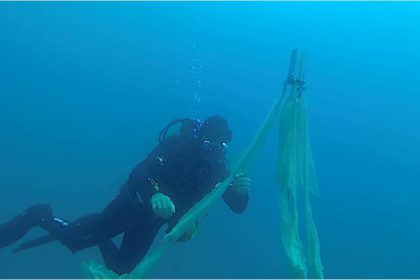
The first depredation mitigation device trials were carried out off Sète, south of France, on August 02 and 07, 2019. Researchers and engineers from IRD, IFREMER and SATIM were involved in those trials, which took place onboard an IFREMER research vessel. This survey aimed at assessing the behaviour of two prototypes (named A and B) in shallow waters. A 35m long mainline was suspended in the water by 6 floats to simulate a pelagic longline. Eight branchlines equipped with eight A and B devices were attached to the mainline. European bass and hake were hooked to each branchline to simulate the captured fish. Once the whole mainline was set, two divers sequentially pulled on the branchlines to simulate a biting fish and trigger each device. Waterproof cameras were used to record the behaviour of each device, from its triggering to the moment it slid down and protected the fish. A total of five line settings were carried out, corresponding to 40 device triggerings.

Configuration of the experimental longline equipped with 4 “A prototypes” and 4 “B prototypes”
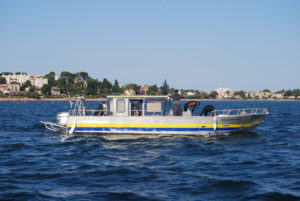
RV Chlamys
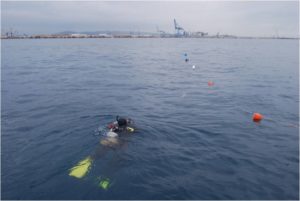
Diver swimming towards the experimental line
“A” device:
The A device is made up of a metallic mobile support, on which four linen veils are attached. The case, attached to the branchline snap with a snap hook, is designed to store the veils. The nylon branchline is inserted inside the device. When a fish is hooked, a metallic element presses down on the mobile support and triggers the device. This releases the mobile support which slides down the branchline. Then, the veils are deployed around the fish and protect it from predators.
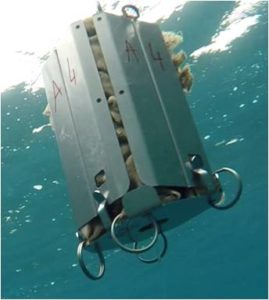
“A Device”
“B” device:
The B device is made up of a cylindrical hollow case attached to the branchline snap. The mobile support is inserted in that case, and is made up of four compartments dedicated to store the veils. The four linen veils are attached at the base of the mobile support. The branchline is inserted into the case and the mobile support. When a fish is hooked, a metallic element presses down on the base of the mobile support and triggers the device. This releases the mobile support which slides down the branchline. Unlike the A device, the veils are still stored in their storage compartment when the B device is triggered. Thanks to water currents or fish movements, the veils exit their storage space, are deployed around the fish and protect it from predators.
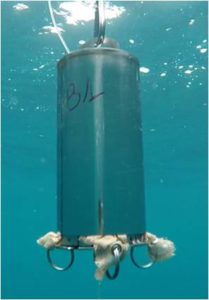
“B Device”
At the end of the survey, recorded movies were used to assess the device behaviour. Several technical factors were analyzed for both devices: setting behaviour, correct functioning of the triggering system, veils deployment, fish protection, hauling behaviour, storage system. We also wanted to assess how quick and easy the device slid down the branchline.
Those analyses resulted in the following satisfaction table:
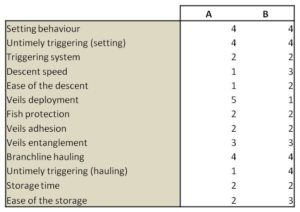
Evaluation of the satisfaction level regarding the behaviour of PARADEP (1: very low level, 2: low level, 3: medium level, 4: high level, 5: very high level)
You can download the preliminary report here (in French).
These first results gave valuable insights to improve the PARADEP device. A second survey will be implemented at the end of 2019 (or the beginning of 2020) to assess the behaviour of the modified devices. This will lead to the mass production of the depredation mitigation device, which will be tested onboard commercial pelagic longliners in Reunion Island from March 2020.



